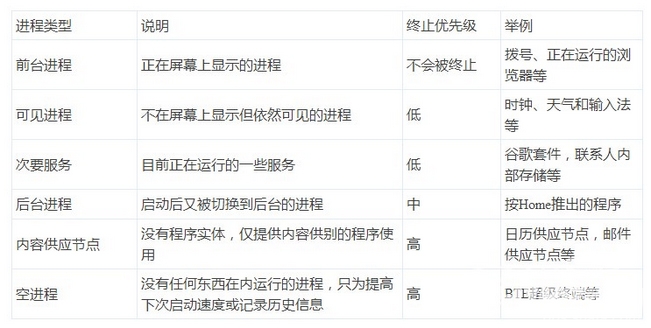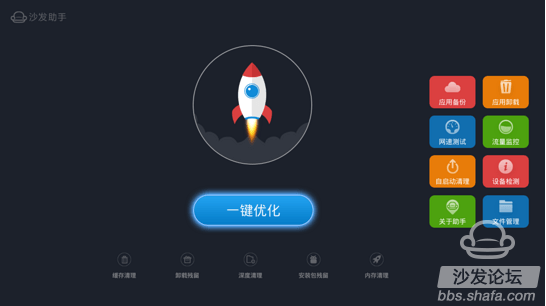In the RK3368 chip set-top box opened mass production mode, Haimei Di, Timmin, cloud network line and other set-top box manufacturers set off the people's crazy eight-core 64 to carry Android 5.1 system set-top box, open-Borre off the road, the introduction of PC-class graphics +4G Memory + 16G flash game God Open Bor F6.
After all, currently on the market, the largest Android set-top box memory is only 2G, and it is also very rare for sale. Only the Lynx Box TMB300 enjoys the sale. Kai Bor F6's 4G memory out of the air, will inevitably cause an uproar.

The most basic and most fundamental reason for watching TV Kartun! I analyzed in this article for everyone, you can install a sofa butler assistant, a key to clean the system cache garbage, end all Android system background running program, no point a little clean, you can make available memory is always maintained In terms of higher capacity, the open-Borer manufacturers also seized the psychology of users craving for large memory, only to launch new products with 4G large memory, capacity almost equal to PC graphics.
So, does Android device really need such high memory? Is it necessary to end all processes without anything?
Unique process management strategy:
To understand the impact of memory on the Android system, we first need to understand its unique process management strategy.
Linux (Android originates from Linux) will automatically end the process after the process activity stops, while Android will keep all your running processes in memory, so that you can quickly call the next time you run, making you feel very Cool. Some of these processes are not terminated until the system needs more memory to free up memory. So, what is the Android system to determine the termination priority of different types of processes?
It turns out that the Android system will assess the importance of each process and give it different size "oom_adj" threshold, the greater the value, the higher the priority that the process is terminated by the system. For example, "When the memory is less than 300MB, all the processes whose "oom_adj" value is greater than 3 are ended." Android systems usually classify processes into 6 categories (see Table 1), where the "oom_adj" value of the foreground process is 0, which means that It will never be terminated, and whether other types of processes are closed depends on the remaining memory of the current system.

It should be noted that the foreground process and background process can be converted to each other. For example, if you are using a browser program to access the Internet, then the browser is the foreground process. But after you press the Home button to return to the home page, the browser process becomes a background process and is terminated when necessary. For example, long-pressing the Home button toggles the recently running program, but sometimes it can be switched to the paused state (from the background to the foreground), and sometimes it becomes a restart (in order to start the new program, it is managed by the process. The mechanism has been eliminated.)
hint:
In theory, the background process does not take up CPU resources (only keep the running state), so it will not consume extra power, but also speed up the next startup. However, some programs, such as QQ or Weibo, will still open a networked service to receive offline messages after they go to the background. Such programs will always consume power.
Extremely memory-consuming applications
The essence of an Android application is java and requires a virtual machine. This means that each time you open an application, you will open a separate virtual machine. The benefit of this design is to avoid the collapse of an application (virtualizer) and cause the entire system to crash, but at the cost of more memory.
Theoretically speaking, the Android system's process management strategy is still quite humane, but it runs into memory-heavy applications (such as large-scale video games, a setting that occupies 43MB of memory, Android application memory requirements are evident), and then large The memory capacity is also "injury." According to the above idea, when we click on the icon of a new application, the system will first determine the memory usage of the program. If it is larger than the current available memory capacity, it triggers the system's own process management strategy. Turn off the process with a high value for "oom_adj". This is an operation that consumes system resources, especially when a program frequently requests memory from the system.
So you will find that also playing a large-scale 3D game, the large memory box will go in a bit (remaining memory is enough), but the small memory box will be stuck for a period of time (the system is scheduling process resources, close the unwanted process ).
Finally, is the smart TV & Android box running memory bigger? The answer is: there is a need
In short, the advantage of large memory for Android devices is to reduce the number of system process scheduling mechanisms, can retain the running status of more applications, allowing you to experience the feeling of quick startup/switching, and small memory devices are running for a while. After time, it seems to be incompetent. From this perspective, large memory is still necessary. However, in the Android 4.x system, 1GB of memory is basically sufficient. When the prices are similar, the 2GB model can be given priority, and it is not necessary to force it.
As for the need to use process management software, 2G, 4G memory is currently basically no need to clean up the system memory, small memory devices can be cleaned up before running a large application, manually help the system to reduce the burden.
However, with the advent of the Android 5.1 system era, the system's requirements for software programs are getting higher and higher. The 2G and 4G system memory boxes are not necessarily fluently used in the Android 5.1 system, so the boxes for different configuration systems are Manually clearing the system memory is a good way to reduce the burden on the system.
Smart TV & Android box software to clean the system process is recommended to use sofa assistant, official website: http://app.shafa.com/apk/shafadianshizhushou.html
Sofa Assistant Introduction Sofa Assistant is a professional TV management software, suitable for major brands of smart boxes, smart TVs. With memory cleaning, cache cleaning, self-start management, application uninstallation, device detection, network speed six functions. More powerful one-click smart optimization, a second full speed! Is your right-hand man watching TV and playing games!

Clear artifact intelligent speed scanning, to achieve super deep cleaning!
One-second speed and easy one-click acceleration to instantly clear cached garbage!
Professional and high-quality sofa net produced, inherited professional butler sofa quality!
Tip: It is recommended to install the sofa butler on the box or TV: http://, you can download and update the sofa assistant with one click!
After all, currently on the market, the largest Android set-top box memory is only 2G, and it is also very rare for sale. Only the Lynx Box TMB300 enjoys the sale. Kai Bor F6's 4G memory out of the air, will inevitably cause an uproar.

The most basic and most fundamental reason for watching TV Kartun! I analyzed in this article for everyone, you can install a sofa butler assistant, a key to clean the system cache garbage, end all Android system background running program, no point a little clean, you can make available memory is always maintained In terms of higher capacity, the open-Borer manufacturers also seized the psychology of users craving for large memory, only to launch new products with 4G large memory, capacity almost equal to PC graphics.
So, does Android device really need such high memory? Is it necessary to end all processes without anything?
Unique process management strategy:
To understand the impact of memory on the Android system, we first need to understand its unique process management strategy.
Linux (Android originates from Linux) will automatically end the process after the process activity stops, while Android will keep all your running processes in memory, so that you can quickly call the next time you run, making you feel very Cool. Some of these processes are not terminated until the system needs more memory to free up memory. So, what is the Android system to determine the termination priority of different types of processes?
It turns out that the Android system will assess the importance of each process and give it different size "oom_adj" threshold, the greater the value, the higher the priority that the process is terminated by the system. For example, "When the memory is less than 300MB, all the processes whose "oom_adj" value is greater than 3 are ended." Android systems usually classify processes into 6 categories (see Table 1), where the "oom_adj" value of the foreground process is 0, which means that It will never be terminated, and whether other types of processes are closed depends on the remaining memory of the current system.

It should be noted that the foreground process and background process can be converted to each other. For example, if you are using a browser program to access the Internet, then the browser is the foreground process. But after you press the Home button to return to the home page, the browser process becomes a background process and is terminated when necessary. For example, long-pressing the Home button toggles the recently running program, but sometimes it can be switched to the paused state (from the background to the foreground), and sometimes it becomes a restart (in order to start the new program, it is managed by the process. The mechanism has been eliminated.)
hint:
In theory, the background process does not take up CPU resources (only keep the running state), so it will not consume extra power, but also speed up the next startup. However, some programs, such as QQ or Weibo, will still open a networked service to receive offline messages after they go to the background. Such programs will always consume power.
Extremely memory-consuming applications
The essence of an Android application is java and requires a virtual machine. This means that each time you open an application, you will open a separate virtual machine. The benefit of this design is to avoid the collapse of an application (virtualizer) and cause the entire system to crash, but at the cost of more memory.
Theoretically speaking, the Android system's process management strategy is still quite humane, but it runs into memory-heavy applications (such as large-scale video games, a setting that occupies 43MB of memory, Android application memory requirements are evident), and then large The memory capacity is also "injury." According to the above idea, when we click on the icon of a new application, the system will first determine the memory usage of the program. If it is larger than the current available memory capacity, it triggers the system's own process management strategy. Turn off the process with a high value for "oom_adj". This is an operation that consumes system resources, especially when a program frequently requests memory from the system.
So you will find that also playing a large-scale 3D game, the large memory box will go in a bit (remaining memory is enough), but the small memory box will be stuck for a period of time (the system is scheduling process resources, close the unwanted process ).
Finally, is the smart TV & Android box running memory bigger? The answer is: there is a need
In short, the advantage of large memory for Android devices is to reduce the number of system process scheduling mechanisms, can retain the running status of more applications, allowing you to experience the feeling of quick startup/switching, and small memory devices are running for a while. After time, it seems to be incompetent. From this perspective, large memory is still necessary. However, in the Android 4.x system, 1GB of memory is basically sufficient. When the prices are similar, the 2GB model can be given priority, and it is not necessary to force it.
As for the need to use process management software, 2G, 4G memory is currently basically no need to clean up the system memory, small memory devices can be cleaned up before running a large application, manually help the system to reduce the burden.
However, with the advent of the Android 5.1 system era, the system's requirements for software programs are getting higher and higher. The 2G and 4G system memory boxes are not necessarily fluently used in the Android 5.1 system, so the boxes for different configuration systems are Manually clearing the system memory is a good way to reduce the burden on the system.
Smart TV & Android box software to clean the system process is recommended to use sofa assistant, official website: http://app.shafa.com/apk/shafadianshizhushou.html
Sofa Assistant Introduction Sofa Assistant is a professional TV management software, suitable for major brands of smart boxes, smart TVs. With memory cleaning, cache cleaning, self-start management, application uninstallation, device detection, network speed six functions. More powerful one-click smart optimization, a second full speed! Is your right-hand man watching TV and playing games!

Clear artifact intelligent speed scanning, to achieve super deep cleaning!
One-second speed and easy one-click acceleration to instantly clear cached garbage!
Professional and high-quality sofa net produced, inherited professional butler sofa quality!
Tip: It is recommended to install the sofa butler on the box or TV: http://, you can download and update the sofa assistant with one click!
The through-wall terminals can be installed side by side on panels with thicknesses ranging from 1mm to 10mm, and can automatically compensate and adjust the thickness of the panel to form a terminal block with any number of poles. In addition, isolation plates can be used to increase air gaps and creepage distances.
Through-Wall Terminal,Through Wall Terminal Block,Through-Wall Terminal Extender,Through-The-Wall Terminal Block
Sichuan Xinlian electronic science and technology Company , https://www.sztmlch.com